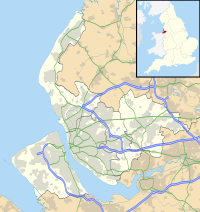All Saints' Church, St Helens
| All Saints' Church, St Helens | |
|---|---|
 All Saints' Church, St Helens, from the northwest | |
| 53°26′14″N 2°42′12″W / 53.4373°N 2.7033°W | |
| OS grid reference | SJ 534,936 |
| Location | Ellamsbridge Road, Sutton, St Helens, Merseyside |
| Country | England |
| Denomination | Anglican |
| Website | All Saints, Sutton |
| History | |
| Status | Parish church |
| Founded | 4 August 1891 |
| Consecrated | 14 October 1893 |
| Architecture | |
| Functional status | Active |
| Heritage designation | Grade II |
| Designated | 2 June 1988 |
| Architect(s) | Paley, Austin and Paley |
| Architectural type | Church |
| Style | Gothic Revival |
| Groundbreaking | 4 August 1891 |
| Completed | 1893 |
| Specifications | |
| Materials | Sandstone, cement-tile roofs |
| Administration | |
| Province | Province of York |
| Diocese | Liverpool |
| Archdeaconry | Warrington |
| Deanery | Saint Helens |
| Parish | Sutton |
| Clergy | |
| Rector | Revds Louise and Simon Moore |
All Saints' Church is in Ellamsbridge Road, Sutton, Merseyside, England. It is an active Anglican parish church in the deanery of Saint Helens, the archdeaconry of Warrington, and the diocese of Liverpool. Its benefice is united with those of St Nicholas, Sutton, and St Michael and All Angels, Sutton, to form the Sutton Team.[1] The church is recorded in the National Heritage List for England as a designated Grade II listed building.[2]
History
All Saints was built between 1891 and 1893, and designed by the Lancaster firm of architects, Paley, Austin and Paley.[3] The land and a donation of £1,000 (equivalent to £140,000 in 2023)[4] were given by the lord of the manor, William Pilkington of the Pilkington glass manufacturing firm. The foundation stone was laid by Pilkington's daughter on 4 August 1891, and the church was consecrated on 14 October 1893 by the Rt Revd John Ryle, Bishop of Liverpool.[5] The architects planned for a tower on the crossing, but this was never built.[3] The estimated final cost of the church was £6,800, and it provided seating for 600 people.[6]
Architecture
Exterior
The church is constructed in red sandstone, and has cement-tile roofs. Its plan is cruciform, and consists of a five-bay nave with a clerestory, north and south aisles, a southwest porch, north and south transepts, and a two-bay chancel with a chapel and a vestry. The architectural style is Gothic Revival. The windows in the aisles and clerestory have three lights, and those in the chapel and vestry have two lights. At the west end are buttresses and a four-light window. The east window has five lights and contains staggered transoms.[2]
Interior
The authors of the Buildings of England series describe the interior as being "impressive" and "dignified".[3] The arcades are carried on octagonal piers with moulded capitals.[2] The piers at the crossing are massive, having been built in preparation for the unbuilt tower. At the west end of the church, two bays have been converted into a parish room, with a glazed screen between it and the rest of the church. The stained glass in the east window is a memorial to the Pilkington family; it was made in 1905 by Shrigley and Hunt.[3] The organ dates from 1900 and was given by William Pilkington.[2] Following a localised fire in the sanctuary area of the church in September 2020, the church is undergoing extensive cleaning and restoration with the plan for it to reopen in the early summer of 2021. The present congregation worship in nearby St Nicholas Church on Sundays at noon.
See also
References
- ^ All Saints, Sutton, Sutton, Church of England, retrieved 5 November 2011
- ^ a b c d Historic England, "Church of All Saints, St. Helens (1260566)", National Heritage List for England, retrieved 5 November 2011
- ^ a b c d Pollard, Richard; Pevsner, Nikolaus (2006), Lancashire: Liverpool and the South-West, The Buildings of England, New Haven and London: Yale University Press, p. 567, ISBN 0-300-10910-5
- ^ UK Retail Price Index inflation figures are based on data from Clark, Gregory (2017). "The Annual RPI and Average Earnings for Britain, 1209 to Present (New Series)". MeasuringWorth. Retrieved 7 May 2024.
- ^ Wainwright, Stephen (2011), An Illustrated History of Old Sutton in St.Helens: History of Religion in Sutton, St.Helens; Introduction, archived from the original on 25 December 2011, retrieved 5 November 2011
- ^ Brandwood, Geoff; Austin, Tim; Hughes, John; Price, James (2012), The Architecture of Sharpe, Paley and Austin, Swindon: English Heritage, p. 239, ISBN 978-1-84802-049-8
- Church of England church buildings in Merseyside
- Grade II listed churches in Merseyside
- Churches completed in 1893
- 19th-century Church of England church buildings
- Gothic Revival church buildings in England
- Gothic Revival architecture in Merseyside
- Anglican Diocese of Liverpool
- Paley, Austin and Paley buildings

